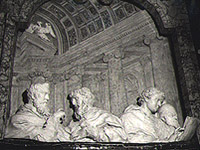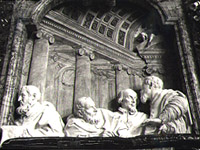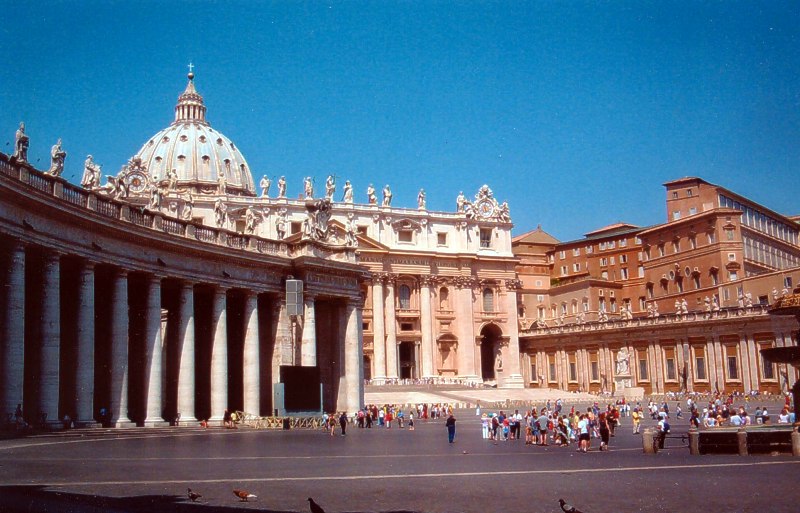Gian Lorenzo Bernini (also spelled Gianlorenzo or Giovanni Lorenzo), born in Naples on 7 December 1598, and died in Rome on 28 November 1680), was an Italian artist who worked principally in Rome. He was the leading sculptor of his age and also a prominent architect. In addition he painted, wrote plays, and designed metalwork and stage sets.
A student of Classical sculpture, Bernini possessed the unique ability to capture, in marble, the essence of a narrative moment with a dramatic naturalistic realism which was almost shocking. This ensured that he effectively became the successor of Michelangelo, far outshining other sculptors of his generation, including his rival, Alessandro Algardi. His talent extended beyond the confines of his sculpture to consideration of the setting in which it would be situated; his ability to be able to synthesize sculpture, painting and architecture into a coherent conceptual and visual whole has been termed by the art historian, Irving Lavin, the Ďunity of the visual artsí. A deeply religious man, working in Counter Reformation Rome, Bernini used light as an important metaphorical device in the perception of his religious settings; often it was hidden light sources that could intensify the focus of religious worship, or enhance the dramatic moment of a sculptural narrative.
Bernini was also a leading figure in the emergence of Roman Baroque architecture along with his contemporaries, the architect, Francesco Borromini and the painter and architect, Pietro da Cortona. Early in their careers they had all worked at the same time at the Palazzo Barberini, initially under Carlo Maderno and on his death, under Bernini. Later on, however, they were in competition for commissions and fierce rivalries developed, particularly between Bernini and Borromini. Despite the arguably greater architectural inventiveness of Borromini and Cortona, Berniniís artistic pre-eminence, particularly during the reigns of popes Urban VIII (1623-44) and Alexander VII (1655-1665), meant he was able to secure the most important commission in Rome of the day, St. Peter's Basilica. His design of the Piazza San Pietro in front of the Basilica is one of his most innovative and successful architectural designs.
A student of Classical sculpture, Bernini possessed the unique ability to capture, in marble, the essence of a narrative moment with a dramatic naturalistic realism which was almost shocking. This ensured that he effectively became the successor of Michelangelo, far outshining other sculptors of his generation, including his rival, Alessandro Algardi. His talent extended beyond the confines of his sculpture to consideration of the setting in which it would be situated; his ability to be able to synthesize sculpture, painting and architecture into a coherent conceptual and visual whole has been termed by the art historian, Irving Lavin, the Ďunity of the visual artsí. A deeply religious man, working in Counter Reformation Rome, Bernini used light as an important metaphorical device in the perception of his religious settings; often it was hidden light sources that could intensify the focus of religious worship, or enhance the dramatic moment of a sculptural narrative.
Bernini was also a leading figure in the emergence of Roman Baroque architecture along with his contemporaries, the architect, Francesco Borromini and the painter and architect, Pietro da Cortona. Early in their careers they had all worked at the same time at the Palazzo Barberini, initially under Carlo Maderno and on his death, under Bernini. Later on, however, they were in competition for commissions and fierce rivalries developed, particularly between Bernini and Borromini. Despite the arguably greater architectural inventiveness of Borromini and Cortona, Berniniís artistic pre-eminence, particularly during the reigns of popes Urban VIII (1623-44) and Alexander VII (1655-1665), meant he was able to secure the most important commission in Rome of the day, St. Peter's Basilica. His design of the Piazza San Pietro in front of the Basilica is one of his most innovative and successful architectural designs.

The Ecstasy of St. Teresa di Avila - Gian Lorenzo Bernini
Gian Lorenzo Bernini
(b. Naples, 1598, d. Rome, 1680
(b. Naples, 1598, d. Rome, 1680
The Cornaro Chapel, in the left transept of the Church of S. Maria della Vittoria in Rome, is the greatest single commission of the Cornaro family outside the field of architecture and one of the most inspired monuments of art history. Cardinal Patriarch Federico Cornaro acquired the chapel rights in January 1647 and commissioned its design and execution by Bernini, 1647-52. Janson in History of Art describes Bernini [p. 410] as "the greatest sculptor-architect of the century" and proclaims the Cornaro Chapel "his masterpiece."
The centerpiece is The Ecstasy of S. Teresa di Avila (shown above), a large statue [height 11 3/8 feet] designed to be illuminated by reflected light from a hidden window. The statue depicts a remarkable mystic experience related by S. Teresa herself:
"Beside me on the left appeared an angel in bodily form . . . He was not tall but short, and
very beautiful; and his face was so aflame that he appeared to be one of the highest ranks
of angels, who seem to be all on fire . . . In his hands I saw a great golden spear, and at the
iron tip there appeared to be a point of fire. This he plunged into my heart several times so
that it penetrated my entrails. When he pulled it out I felt that he took them with it, and left
me utterly consumed by the great love of God. The pain was so severe that it made me utter
several moans. The sweetness caused by this intense pain is so extreme that one can not
possibly wish it to cease, nor is one's soul content with anything but God. This is not a physical
but a spiritual pain, though the body has some share in it -- even a considerable share."
The centerpiece is The Ecstasy of S. Teresa di Avila (shown above), a large statue [height 11 3/8 feet] designed to be illuminated by reflected light from a hidden window. The statue depicts a remarkable mystic experience related by S. Teresa herself:
"Beside me on the left appeared an angel in bodily form . . . He was not tall but short, and
very beautiful; and his face was so aflame that he appeared to be one of the highest ranks
of angels, who seem to be all on fire . . . In his hands I saw a great golden spear, and at the
iron tip there appeared to be a point of fire. This he plunged into my heart several times so
that it penetrated my entrails. When he pulled it out I felt that he took them with it, and left
me utterly consumed by the great love of God. The pain was so severe that it made me utter
several moans. The sweetness caused by this intense pain is so extreme that one can not
possibly wish it to cease, nor is one's soul content with anything but God. This is not a physical
but a spiritual pain, though the body has some share in it -- even a considerable share."

Left Balcony

Right Balcony
The figures of S. Teresa and the angel are seen upon a stage, witnessed by Cardinals and Doges of the Cornaro family looking on from flanking balconies.
The chapel is decorated with stuccos and frescos executed by Guidobaldo Abatini to Bernini's design.

St. Peter's Square, The Vatican
During his long career, Bernini received many important commissions, many associated with the papacy. At an early age, he came to the attention of the papal nephew, Cardinal Scipione Borghese, and in 1621, at the age of only twenty three, he was knighted by Pope Gregory XV. Following his accession to the papacy, Urban VIII is reported to have said, "Your luck is great to see Cardinal Maffeo Barberini Pope, Cavaliere; but ours is much greater to have Cavalier Bernini alive in our pontificate". Although he did not fare so well during the reign of Innocent X, under Alexander VII, he once again regained pre-eminent artistic domination and continued to be held in high regard by Clement IX.
Bernini and other artists fell from favour in later neoclassical criticism of the Baroque It is only from the late nineteenth century that art historical scholarship, in seeking an understanding of artistic output in the cultural context in which it was produced, has come to recognise Berniniís achievements and restore his artistic reputation.
Bernini and other artists fell from favour in later neoclassical criticism of the Baroque It is only from the late nineteenth century that art historical scholarship, in seeking an understanding of artistic output in the cultural context in which it was produced, has come to recognise Berniniís achievements and restore his artistic reputation.